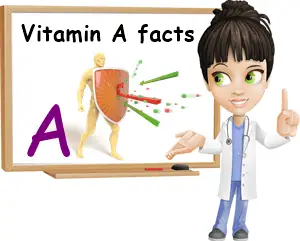Vitamin A is actually a general name given to several naturally-occurring compounds that fulfill specific functions in the human body. Retinol, retinoic acid and retinal are various forms of vitamin A proper. Carotenoids, orange pigments occurring naturally in foods such as carrots, apricots, sweet potatoes or pumpkin are antioxidants and color-giving compounds, but because our body can partially convert them into vitamin A, they also posses vitamin A activity and are known as pro-vitamin A compounds.
Beta-carotene, alpha-carotene, gamma-carotene and beta-cryptoxanthin are the main carotenoids with vitamin A activity. Other carotenoids such a lutein or zeaxanthin have only antioxidant properties, though they are just as beneficial for our health. Vitamin A-proper and pro-vitamin A carotenoids are absorbed differently. Generally, vitamin A proper from animal food sources such as fish liver oils and fish, poultry liver and giblets, beef liver, milk, dairy products such as ricotta cheese or eggs is better absorbed than the carotenoids from plant sources such as apricots, carrots, cantaloupe, sweet potatoes, red peppers, spinach and other green leafy vegetables.

The forms of vitamin A our body absorbs best are those from animal food sources. One of the reasons why vitamin A from eggs, milk, dairy, liver and giblets has a higher absorption rate is because animal food sources contain generous amounts of lipids (fats) which are crucial for vitamin A absorption, not to mention the nutrient is preformed. Carotenoids are not yet vitamin A, so our body has to absorb them, then turn them into vitamin A. But it cannot synthesize them properly and completely, so we get less of the vitamin or would have to eat much more plant sources of the nutrient to meet our demands.
Plant vs animal sources
Getting our vitamin A from animal food sources is a great approach approach since the vitamin in animal foods is much more bioavailable. But since animal foods are often high in fats, it’s important to remember not to eat too much to avoid weight gain and cardiovascular problems. It’s best to take our vitamin A from both animal and plant sources and thus not only meet our daily requirements of the nutrient, but also enjoy an overall healthy diet. If we choose plant foods as our only source of the vitamin, we have to make sure that what we eat is organic or at least does not contain dangerous pesticides or chemicals in values well above the legal and safety limits.
Vitamin A is usually measured in mcg (micrograms) RAE (retinol activity equivalent). Retinol activity equivalent is a unit designed to measure how much of each form of vitamin A we would need on a daily basis. Vitamin A from plant sources being less bioavailable, we would need more of it than the preformed retinol to achieve the same benefits. Another commonly used measure unit is IU (international units).

How much vitamin A per day?
The recommended daily allowance for an average adult is estimated at:
1) Adult man: 900 mcg (micrograms or μg) a day.
2) Adult woman: 700 mcg/day.
3) Pregnant woman: 770 mcg/day.
4) Nursing mother: 1300 mcg/day.
Equivalent in food sources
This means an average adult male would have to eat the following in one day to get all of his vitamin A:
1) A little over 100 g of raw carrots (835 mcg RAE/100 g).
2) About 21 g of pan fried chicken liver (4296 mcg RAE/100 g).
3) About 100 g of sweet potato, baked in skin (961 mcg RAE/100 g).
4) Around 171 g of boiled and drained spinach with salt (524 mcg RAE/100 g).
5) About 570 g of sweet, raw red peppers (157 mcg RAE/100 g).
6) About 950 g of raw apricots (96 mcg RAE/100 g).
7) Around 115 g of canned, unsalted pumpkin (778 mcg RAE/100 g).
8) Almost 6 large eggs, poached at 50 g an egg (160 mcg RAE/100 g).
9) About 9 large eggs, fried at 45 g an egg (101 mcg RAE/100 g).
10) A little over 130 g boiled, drained, unsalted kale (681 cmg RAE/100 g).
The above 10 examples are the best options for meeting our daily demands. If we don’t like liver, giblets, sweet potatoes, red peppers, carrots or spinach, we might have too eat more of other foods to get all of our vitamin A for just one day. And while this is just one of 26 essential vitamins and minerals we need on a daily basis, the nutrient takes care of several vitally important aspects of our health.
Upper limit of vitamin A
The maximum amount of vitamin A per day is 3000 mcg (micrograms) for adult men and women and is known as the upper limit. In other words, it’s about as much of the vitamin you can get without experiencing what is known as hypervitaminosis A side effects. This means that the average person may exceed their recommended daily allowance and eat as much as 3000 mcg of vitamin A in one day or several days in a row without side effects, but it might not be best to have an intake this high every single day. However, different people have different nutritional needs. Some may benefit from double the intake, especially if already deficient or if their body is, for some reason, be it disease or stress, consuming more vitamin A than what we know is normal.
However, you can’t really eat too much vitamin A if you enjoy an overall healthy, balanced and varied diet (if you don’t eat right, you are probably not getting enough vitamin A). You would have to target specific foods high in vitamin A and eat them obsessively to be able to notice the side effects of too much vitamin A. Our body is generally great at assessing how much of the nutrient we need. It can store some of the vitamin A we take in if it’s too much, convert as much beta-carotene it needs to meet its vitamin A needs if we don’t get enough. Malabsorption problems, certain diseases that alter our fat metabolism (because fats help absorb the vitamin), not eating enough fats or not eating them at all, stress, growth, pregnancy, lactation may all increase average requirements.
Vitamin A toxicity
How and when does does it occur? Vitamin A toxicity occurs when our intake is too high for too many days. How much vitamin A should we take per day to develop toxicity symptoms and where should we get it from? Because it’s very hard to do so on a normal, varied and balanced diet, it would have to occur only if we took multiple dosages of dietary supplements and ate certain foods obsessively. Moreover, the dietary supplements would have to be preformed vitamin A such as retinol for toxicity to occur because our body absorbs retinol directly, whereas beta-carotene and other pro-vitamin A forms need to be converted by the body first.
Why don’t beta-carotene supplements cause vitamin A toxicity? Because our body has to absorb beta-carotene, then transform some of it into vitamin A proper and the rate at which it synthesizes its vitamin A from it is not fast enough to cause dangerous amounts of the nutrient to accumulate in tissues or the liver. This goes for all carotenoid-based supplements.
Signs you are getting too much vitamin A
The signs and symptoms of vitamin A toxicity may include: nausea, dizziness, headaches, bone and joint pain, skin and liver abnormalities, liver damage, increased risk of cardiovascular disease and lung cancer in smokers and even death, birth defects. Research suggests that abnormally high intakes engender more serious side effects. Moreover, it’s extremely difficult to develop toxicity effects from dietary vitamin A. As mentioned above, toxicity is most likely to occur from too high a intake of retinol from dietary supplements. Even then you would have to take more than the recommended dose of the supplement.
The side effects of too much vitamin A depend on how much of the nutrient we take in, how long we exceed our intake and whether or not we need a lot of vitamin A to begin with. For example, certain categories of people who are at risk or already deficient in vitamin A might benefit from an increase in their daily intake. Children born prematurely, children and pregnant women subjected to malnutrition or starvation are at risk.
Conclusion
Vitamin A is crucial for various aspects of our health. Our eyes, our mucous membranes (lining of the nose, mouth, throat, stomach), our skin, lungs and entire immune system benefit from an adequate intake. The only problem with the nutrient is that it is fat-soluble, meaning it is transported via fats and is stored in fat tissue. A normal diet is unlikely to supply us with too much of the nutrient, but if we exceed the recommended dosage of our dietary supplements or eat certain foods extremely rich in vitamin A obsessively or excessively (fish oil, for example), then we might risk accumulating too much and this may have toxic effects that can get serious if we do not discontinue use. However, vitamin A remains vital and supplementation is often necessary to complement deficient diets.
